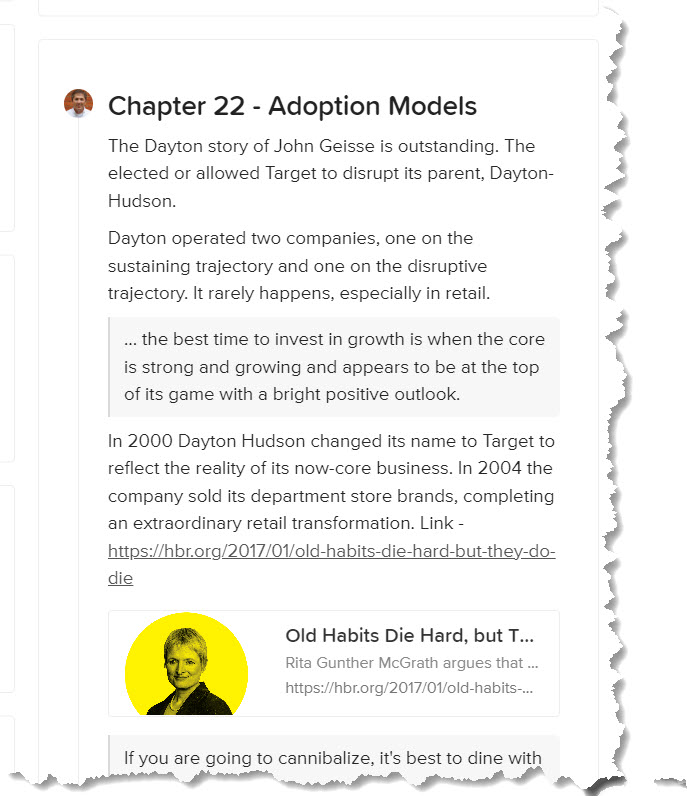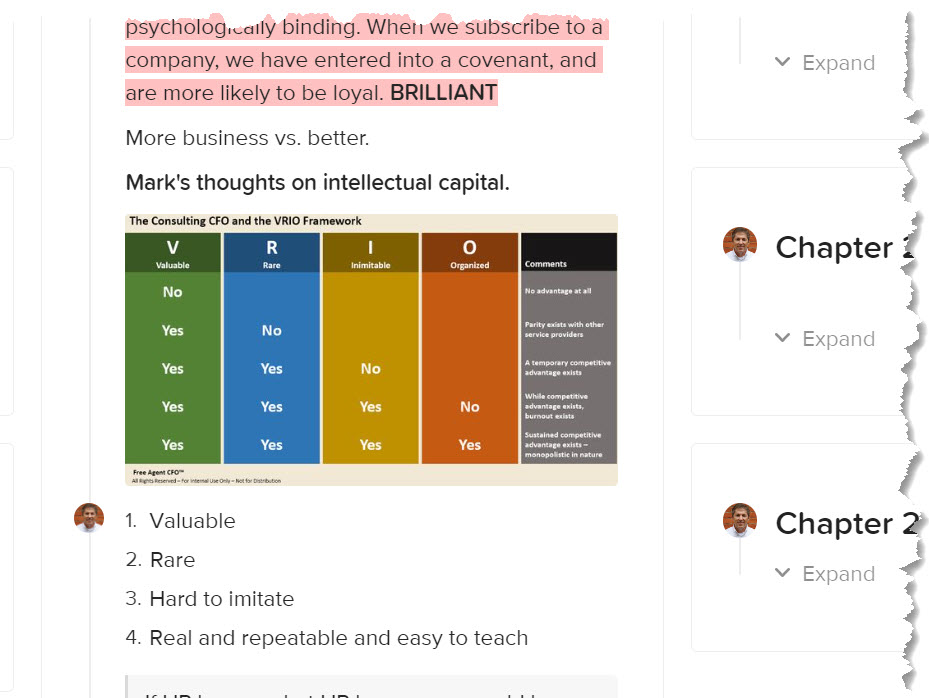The subscription economy is alive and well for products-based businesses and the software industry. But how about professional services firms? Does the subscription model apply to accountants, lawyers, consultants, marketers, and other professionals? Ron Baker founded VeraSage Institute, the leading think tank dedicated to teaching value pricing to professionals worldwide. He’s the co-host of The Soul of Enterprise podcast, and he’s the author of numerous books, including his newest title, Time’s Up!
Interview Highlights
- Ron’s hope for readers one year from now
- Are we finally done talking about the billable hour?
- Transformations and outcomes
- Fender’s inspiring example of subscription/membership done right
- DPCs are the best role models for professional firms
- The two most important questions before embarking on this model
- Do we ease in or go all in? Insights from Dayton-Hudson
- Valuable, rare, and hard-to-imitate intellectual capital
- Professionals vs technicians
- Pricing the subscription model in professional services
- The strong links between purpose and profitability
- Mark’s recommendation for getting started on a membership/subscription model
- The lightning round: caterers and line cooks, plussing, surrogation, pragmamorphism, liminal thinking, ensure, and battered patient syndrome
- The most inspiring book Ron has recently read
Moving to the subscription economy means we have to learn not to monetize the transaction but rather to monetize the relationship.
Ron Baker – Time’s Up!

Favorite Chapters
I tend to read management books in reverse order for about five chapters, then I jump around haphazardly. Accordingly, these are not in order:
Chapter 22 – Adoption Models
I loved the chapter on adoption models because if the reader is in doubt about a move to a subscription model, inspiration and evidence are clearly provided in the Dayton-Hudson story regarding their pivot to Target. This retail story relates to professional services firms of any type.
Three strategies are offered to CEOs contemplating a move to a subscription-centric model: 1) create a new firm, 2) a gradual pivot, or 3) transform. Examples are provided for each strategy, along with the author’s recommendation.

Chapter 17 – Pricing the Portfolio
This chapter stands out because it’s healthy and starts off with a reference to the AICPA Code of Ethics, which I have not read in years. The bullet points that Ron pulled from this dry document were a breath of fresh air, especially item number one, which is due care, aka, “Do no harm.”
Readers and listeners of Ron Baker will probably not learn anything new, but some of the critical ideas include tip clauses, value guessing, price branding, and the inclusion of Amazon’s price increase letter for Prime members. I had not read that–excellent!
In my notes, I wrote down bridges and buildings. These structures are not constructed on a member/subscriber model. But that doesn’t mean you cannot allocate a percentage of your professional services firms to buildings and bridges (the analogy I use in my consulting practice).
Chapter 9 – The Direct Primary Care Disruptors
Ron said he loved writing this chapter.
I loved reading it.
Here’s what I liked:
- Dr. Brian Nadolne’s quote
- Tzuo’s quote on either being expendable or indispensable
- The three words leading down Google’s rabbit holes: cyberchondria, battered patient syndrome, and ikigai
- I had read this from Ron before, but the reference to MD2 was informative and useful
- The reason for being a DPC on page 115 should be turned into a large poster in your conference room
- The shortlist of objections was not new, but I enjoyed the inclusion
Any CEO of a professional firm that’s unsure about the subscription model should read this chapter first.
Chapter 8 – A Renaissance: The Subscription Economy
For the casual reader thinking they should read chapter nine first, don’t do that. Read the chapter immediately before it first, as Ron provides some context to the subscription economy. He also gives the timeline for one of the most successful subscription/member models ever introduced to customers–it’s the Fender guitar case study.
In this chapter, readers will learn the Latin term for transaction. I loved the Michael Hammer quote on the difference between providing a result and performing a task. Regarding quotes, this was my favorite:
It (the subscription model) puts the customer relationship at the heart of the business. There are no silos or profit centers; it is a true one-firm business model.
Chapter 8 – Time’s Up!
Other Chapters
The tenth chapter on business model evolution led to the most reflective thinking compared to any other chapter in this book, probably because of the evolution I’ve gone through in my practice dating back to the early 2000s.
Chapter 10 brought back some key insights that Ron wrote in one of my favorite titles of his, Mind Over Matter (five stars in my book). I was also reminded of the framework I hit over and over again with other consultants I mentor and coach. In short (my Missouri country definition), intellectual property is the catalog of frameworks you own that drive profits in your business. I call those frameworks intellectual property. Every professional services firm should have at least three, and one of those should stand out from the others. If not, reread chapter ten.

One of the first one hundred episodes on The Soul of Enterprise introduced listeners to the Smile Curve. Ron includes that mental construct in chapter sixteen in addition to adaptive capacity (one of the most important concepts in moving to the member/subscriber model), anchoring, and the paradox of choice.
The twelfth chapter deserves a mention because of a great quote on moats. As a longtime Pat Dorsey fan, I could probably write a term paper on moats with a gazillion Buffett quotes. This book has cited the best ‘moat’ quote I’ve ever read, “I want to draw a moat around our best customers …”
Critics of the doctrine of moats call this concept too abstract. If so, then the Bezos quote gives us a concrete primary aim when digging and filling a moat around our precious business. I’ll never be able to get that quote out of my head, it’s that good.
I might sound like a broken record, but if you listen to Ron’s podcast, you know where he stands on ESG. Accordingly, this chapter may not offer new insights. Still, Ron’s thinking on ESG is sound, baked deeply in common sense wisdom, and offers a better approach behind these three letters for the minority who are seeking utopia in a business world where imperfections will always exist. Some of the examples mentioned in this chapter fall under the category of, “Wow!”
Intellectual Property and Google’s 70-20-10 Rule
I first read about Google’s 70-30-10 Rule in the book Brick by Brick. I highly doubt Google continues to push its engineers to follow a priority work system such as the following:
- 70 percent of time spent on core products
- 20 percent of time spent on extending the fringes of the core products
- 10 percent of the time spent on projects impacting the future
While there may only be shades of truth to this working framework, it’s still a starting point for CEOs and leaders of professional firms when it comes to learning and innovation.
Let’s assume you work 47 weeks a year, which equals 235 working days. That means about 24 days should be dedicated to working on projects impacting the future of the subscription-based firm, right? Is that too much? Too little? And if it’s about right, where does the intellectual capital come from to get the most of that 10 percent?
This is why chapter ten in Ron’s new book took me about a week to fully absorb. Let me repeat, read Mind Over Matter after this book.
My Expanded Vocabulary
You never finish reading a Ron Baker book without having your mind expanded. I’m still shaking my head with the new words I learned.
My list is much longer, but here are a few words that stand out:
- Pantometry
- Mattering
- TaaS
- Ikigai
- Surrogation
- Cyberchondria
- Fish Model Subscription
- Liminal Thinking
- Ensure (Ron’s unique definition)
- Pragmamorphism
Final Thoughts on Time’s Up!
One of my favorite CEOs maintains only two lists on a legal pad. The left half is everything he needs to do right now. The right side includes his top five priorities, which could span a one-year time period.
This is not a how-to book. Don’t expect to find a roadmap providing a starting point, a middle, or an end if you are thinking about a subscription model for your professional firm. I’m glad because that could potentially lead to a bunch of copycats in several services sectors.
Instead, this book causes the CEO or managing partner to pull out her legal pad and create two lists: 1) what I want to do right now, and 2) my top priorities. I’d draw a third line near the bottom third of the paper and write down ideas sparking interest that you want to study later.
As a customer of this deeply-insightful book who invested three weeks not only reading the book, but devouring dozens of additional articles to help augment my thinking on Ron and Paul’s writing, I have three strong opinions that I had before I read this book that only got stronger. And that’s with a full understanding of the concepts of paradigms and liminal thinking.
Plussing. Ron loves this concept. I do too. Years ago, Ron published a series on LinkedIn about his time at the Disney Institute. I particularly enjoyed the second installment of his three-part series, where he introduces the activity of plussing. I don’t know if the late Walt Disney would agree with me, but I view plussing the way I view relationships. For people we love and care about, we should always be plussing. That is, doing things that make the relationship more special. Plussing is an impulse action based on deeply-held beliefs we have about the way we treat others. Plussing needs no training, just modeling from the CEO or managing partner who does this daily. Once plussing becomes a habit, it becomes muscle memory that will never wear off unless we quit flexing that action.
I mention plussing because this action should be normal in any professional firm. But be careful. Plussing is all about the relationship(s). Plussing never replaces the need for careful examination of the underlying subscription model. If the CEO and her leadership team are not continually enhancing or reinventing the subscription model, we might be plussing our way into obscurity.
Does that mean plussing takes a back seat? Never. Plussing is a way of life, provided we sincerely care about the people we serve. Plussing will continue into any enhanced or redefined business model that the CEO executes.
Transformation. This (in my humble opinion) is a deeply spiritual word. It’s a word I use a lot. No, too much. I did a quick search in Outlook, and this word pops up a lot going back to the beginning of time per my Outlook pst file.
I don’t have a word count on the number of times that Ron and Paul used this word, but transformation is used frequently. It’s not a bad word. I just fear that overuse will lead to numbness of the term. Transformations are very rare, especially in a spiritual sense. And that’s why for several years, I’ve been using a term that Jack Waters used many years ago as the Publisher of Tribune Publishing Co., a once leading newspaper in Columbia, Mo. Jack always talked about outcomes or desired outcomes.
In my opinion, leaders in professional firms should be in the business of desired outcomes. As transformations occur, a rare event, we don’t talk about them; we let our customers do that for us. Besides, we’re not the ones who say when, where, or how a customer has been transformed. The customers let us know that.
I love transformations. I love transformation stories. I love them more when I see them taking place with the clients I serve. But I’m keeping a level head on transformations. I cannot control them. I can control outcomes.
Subscription-like. Not every professional firm can move to a subscription model. One of my favorite CEOs in Texas runs a large appliance care firm where we get about $125 per visit. “Bob, what about the subscription model?” Bob tells me he’s been thinking about this for five years. He attends Vistage and the Strategic Coach. So he’s around great thinkers continually. Through feedback and doing his own testing, a subscription model will never work for this model.
One of my close friends is a director and part-owner of an M&A firm focusing on middle-market CEOs who want to sell their businesses in twelve months. There is no subscription model for M&A (actually, they could pull a Fender, but the dollars would be minimal).
My favorite analogy is bridge and building builders. About ten years ago, I worked with a cabinet maker with clients across the U.S. They are a rare bird in that their free cash flow (operating cash flow after debt service and required IRS tax requirements) exceeds 17 percent annually. They are bridge and building makers in that their work is based on one-off projects.
It was working with this firm that I started to deeply-formulate my subscription-like opinion. When a services-centric business does one-off jobs or projects (think estate planning gurus), the business model can become subscription-like once the marketing and selling process is working on all six cylinders. With the cabinet firm I’m mentioning, our marketing and sales funnels became predictable and consistent. It took much work to achieve those numbers, but it worked.
Ron and Paul were generally silent on this topic. If you love M&A work, don’t toss it. If you love implementing Intacct, Dynamics NAV, or doing one-off models in Anaplan, you don’t need to stop. Create the back-end systems and processes which mimic a subscription-like cadence with this part of the bridge and building business.
How to Read This Book
If you are thinking about a shift to the subscription model, find four or five other CEOs who are thinking about the same thing. Read the book over the next 90 days together. Then connect about every two weeks to discuss your favorite ideas and your new priorities.
I loved my three years at the Strategic Coach, and I recommend them to every CEO I serve. My recommendation on how to read this book is by creating a Strategic Coach experience, only without the moderator. I’m so bullish on this concept, I’d love to be a fly on the wall recording the first meeting among these CEOs.
If this is the approach you take in reading the book, don’t forget to check out Collective 54, one of the best mastermind communities for professional services firms.
If you are a solopreneur who is considering a move to the subscription/member model, then Ron and his podcast co-host have an offering that I strongly recommend. They do this for firms, but I still think for individuals, I’d use them for support and guidance.
Episode Pairings
If you liked this episode, here are a three others to consider:

Hi Mark,
So timely! The firm I just joined is moving quickly to the subscription model and this podcast will help move the needle. Thanks!
Neil, thanks for the feedback.